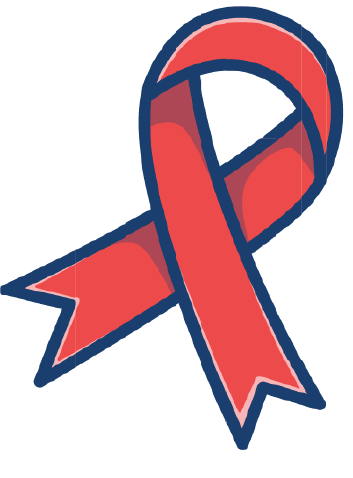AIDS
HIV, or human immunodeficiency virus, is a type of virus that can cause a disease called AIDS (Acquired Immunodeficiency Syndrome). HIV infection affects the immune system, i.e. the body’s natural defences against the disease. Serious diseases can develop if it is untreated. Infections that are normally harmless, such as flu or bronchitis, can worsen, become very difficult to treat or even lead to death. Furthermore, the risk of cancer is also increased.
What distinguishes HIV from other viruses, is that it affects the immune system by attacking the CD4 T cells. The role of these cells is to co-ordinate the immune response when a virus is detected. When HIV uses CD4 cells to spread, it damages and destroys them. In the process, HIV undermines the immune system from within, which is responsible for fighting it.
Transmission
HIV is transmitted through body fluids: blood, semen, vaginal secretions, and breast milk. These body fluids only transmit HIV if they come into contact with an area that lets it enter the body, such as a mucous membrane. Healthy skin is impervious to HIV.
Usually, the virus is contracted during unprotected sex or was previously contracted through sharing needles among injectable drug users. There is no transmission risk through kissing with saliva exchange.
In most industrialized countries, anal sex between men is the predominant route of HIV transmission. However, heterosexual transmission has significantly increased since the start of the epidemic.
![]() Untreated HIV infection leads to AIDS and eventually death.
Untreated HIV infection leads to AIDS and eventually death.
Since HIV infection is more and more treatable, some at-risk populations are becoming complacent with their preventative efforts.
.
HIV is not transmitted in the following ways
It cannot be contracted through shaking hands, sweat or tears. It is not carried by insects. It is not contracted from toilet seats, or from public swimming pools, sharing food or using an infected person’s clothes, towels or telephone.
HIV-AIDS: a more treatable disease
It is now known that a well-treated, HIV-positive person has an extremely low risk of transmitting HIV through sex given certain conditions:
- Medication is taken regularly,
- This results in an undetectable viral load (or a viral load below 50 copies/ml in plasma for more than 6 months and at the most recent test),
- The viral load is measured regularly, at least every 3 or 4 months
- Both partners are free of sexually transmitted infections.
IN SUMMARY
- HIV can be transmitted through unprotected sex (vaginal or anal) and oral sex with an infected person
- It can also be transmitted through transfusion of contaminated blood or by sharing contaminated needles, syringes or other sharp instruments.
- It can also be transmitted from mother to child during pregnancy, childbirth or breastfeeding.
- AIDS is the end stage of infection with human immunodeficiency virus. The word AIDS is an abbreviation of acquired immunodeficiency syndrome.
- According to WHO and UNAIDS estimates, 38 million people were living with HIV at the end of 2019. Around 23 million of them are in Africa. AIDS has caused the death of nearly 700,000 people.